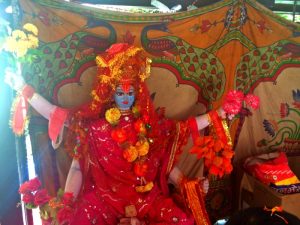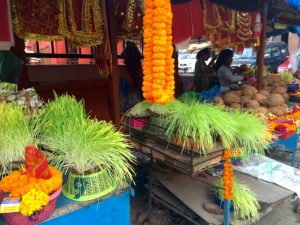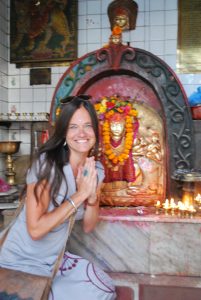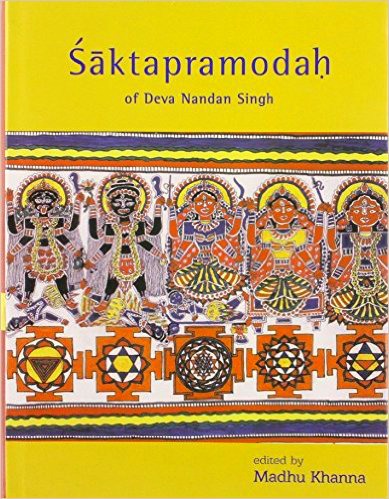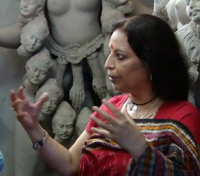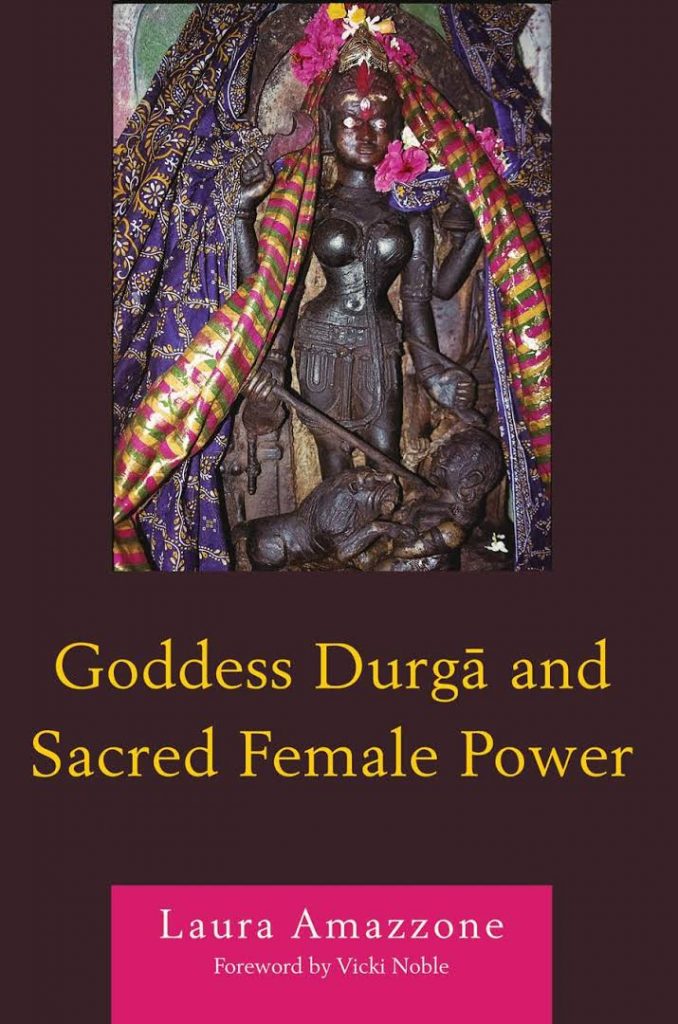 In a few days is the September new moon (Wednesday the 20th) and the beginning of the annual fall festival in India and Nepal of Navaratri or called Durga Puja.
In a few days is the September new moon (Wednesday the 20th) and the beginning of the annual fall festival in India and Nepal of Navaratri or called Durga Puja.
In honor of this transformative celebration I share and recommend a great companion guide to read throughout the festivities or anytime, Goddess Durga and Sacred Female Power by Laura Amazzone. The book transports you into the heart of the sacred feminine and Durga Puja, the largest modern day commemoration to the Divine Mother on the planet with roots that reach back 5000 years. Through vivid storytelling Amazzone shares with us how people come together during this time of year “to celebrate the ancient mysteries of life, death and rebirth on the personal, social and cosmic level.”
Divided into three sets of three days and nights, the festival is dedicated to different aspects of Durga, of Goddess: MahaKali, MahaLakshmi, and MahaSaraswati. All faces of Goddess in their “Great” forms of which Amazzone elucidates on, to helps us understand the inner workings of how the dedicated days of specific goddess worship are guides to assist one on our path to inner balance and liberation. She explains how this yearly event focuses on honoring the cyclical nature of existence and how it promotes empowerment and freedom of the individual and universal. In addition, she goes into depth about various aspects of Goddess, as Kumari, the Navadurgas and more, plus the practices and rituals of renewal and regeneration fundamental to Navaratri.
Goddess Durga and Sacred Female Power is a profound introduction and exploration of Durga and goddess traditions of the Kaula, Shakta and Tantric cultures in Nepal and India. Plus, the healing and power to be found and accessed within these ancient sophisticated traditions.
Through scholarship and personal accounts Amazzone allows the reader to enter into the world of female-centered deity worship and reverence. The Devi Mahathyma is the sacred text of Navaratri, which the author narrates important key parts of this ancient mythology, where Durga is central. Through the writer’s life experiences and struggles and study of the this important manual she shares with us its relevancy to our lives today. She also reveals wisdom and guidance found in this fifth century seminal work, also known by the names of Chandi Path and Durga Saptasati, of which offers us a divine feminine path to realize one’s divinity and be in the world where female power is honored and revered.
The first part of Goddess Durga and Sacred Female Power gives one a framework and understanding as what is nondual Tantra and Goddess and Her place and power in our lives and cosmos. The later, follows day by day the unfoldment of the nine night festival through Amazzone’s daily pilgrimage experiences, recountings rich in tradition details and insights. She also exposes how forms and structures of ongoing patriarchy have not served, nor are positively providing for the health and equlimbrium of the world and people today.
Throughout the book she shares encouraging and inspiring examples from her own life of how these spiritual pathways have assisted her in overcoming and meeting head on life traumas. Thus, allowing the reader to viscerally enter and begin to understand the healing and life-empowerment to be accessed through female-centered deity practices, ones that uphold female sacredness and the importance of female power.
Amazzone’s writing is the heart-soul of Devi, well-researched and experienced. One feels as if you too are on pilgrimage in Nepal or India kneeling and offering flowers at the feet of Goddess.
Blessed, Laura Amazzone was open to interview to share with us a bit more about the book, her relationship to Durga and the Chandi Path, and how these ancient teachings are vital to our lives today…
Stephanie Renee dos Santos: What moment or pivotal situation prompted you to write Goddess Durga and Sacred Female Power?
Laura Amazzone: There was actually no one pivotal moment. Since I was 6 years old I knew I was going to write a book (and hopefully books). Spirituality and women’s rights and studies have been a central issue and passion in my life for as long as I can remember. I have continuously been guided on this path and there have been many synchronicities and divine displays that led me to writing and finally publishing the book in 2010. On a practical level, Goddess Durga and Sacred Female Power evolved out of a Master’s Thesis for the California Institute of Integral Philosophy and was, in part, going to become a dissertation until I decided I did not want to go the route of academia. I was actually told by an adviser at one of the PhD programs I interviewed at that I would have to cut off the mystic/Yogini/devotee in myself to be taken “seriously”—and that one of the professors there had “had no interest in my feminist and subaltern perspective!” (My story about how I came to the subject for my thesis is in the book). At this time (early 2000s) I was working very closely with a Kaula Odiyya (Shaman) and author, Amarananda Bhairavan. At a certain point, he said to me, “No more new sadhanas or mantras for you. Your sadhana and dharma is to write this book on Durga.” He actually wanted me to include more of my personal story. While I did include some key stories, I left a lot of those mystical experiences out because I wanted to honor the researcher in me and really ground the work not only in experience, but also in looking at the historical, social, cultural and religious context. So there is a whole other book waiting to eventually come out on this subject. Other mentors and teachers like author Linda Johnsen, who read a draft of my thesis, told me it was my dharma to publish it as a book. Shaman, Author, Co-creator of Motherpeace Tarot, Vicki Noble was a huge teacher and supporter as was author Elinor Gadon, and many other Feminist Spirituality foremothers. Alice Walker was another powerful mentor who personally encouraged me to write this book on Durga while I was working as her executive assistant for several years. It was not a matter of if I would write a book on Durga, but when and how much to include.
SRDS: How did you learn that you were a “Daughter of Durga”?
LA: When I first met the Kumari in 1998 I recognized something in Her that was very familiar. Being in the Kathmandu Valley I felt like I had come home and I did not want to leave this young living Goddess. I could not rationally explain it but receiving Her darshan changed me forever. I actually stood in Her temple courtyard and made a vow to dedicate my life to Her even though I did not really know who She was in that form! When I started researching the Kumari and learned about the Durga Myth I knew I had a very deep connection to this Goddess—in many ways the myth was describing my personal story and also affirmed much of what I was observing in my own culture—all the ignorance, greed, abuse of power, violence, destruction, misogyny, sexism, racism, homophobia, etc. The next time I returned to Nepal (in 2000) for the Durga Puja, every where I went Sadhus, Pujaris, Yogins, Matas would “randomly” tell me I was becoming Durga, or that I was Durga. I did not even really know fully who Durga was at this time and found it strange, how could I be Durga? What did that mean? I remember being at the burning ghats in Pashupatinath and sitting with the Milk Baba there. He said to me, “I see Durga all over your face, you are becoming Durga.” Honestly I was uncomfortable hearing this as I was not sure what to do with it. I started looking into what it meant within the Shakta Tantra context to be Durga, what it meant to have an Ishta Devata (a personal deity), and discovered how each of us ultimately is a “daughter” or “son” or we could say, embodiment of these different expressions of Consciousness. I am not unique, we all have Durga’s Consciousness within us—whether or not we connect to it or know Her in this or Her myriad other expressions. I believe it came out so strongly in me because I have a strong dharma to embody Her and share this ancient and very necessary wisdom for these times.
Also, a couple years later after much study, practice, and devotion, Amarananda gave me the spiritual name, Ambika (a name for Durga). I actually have many different stories of how I realized the depth of my connection to Her and over lifetimes. There has been a sort of mandala of experiences and reflections that have led me into my center and showed me my place within this existence.
SRDS: When and how did you first start working with Chandi Path?
LA: During the Durga Puja in 2000 in Nepal, I was given a copy of the Chandi Path from a Tantric practitioner. When I returned to San Francisco I showed it to my professor, Dr. Jim Ryan, who is the Director of the Asian Comparative Studies program. He told me this was a very rare copy of this text—that I may be one of the only people in the States to have this and that I needed to study it and perhaps even write my thesis on the Devi Mahatmyam! Again I got the message that Durga was calling me and I needed to write about Her story. I started comparing this text with other translations of the Chandi Path/Devi Mahatymam. It became part of my daily practice with Amarananda and he told me I would eventually teach it. Like with the book and all the synchronicities that came for me to write it, many of my primary teachers have told me I needed to TEACH the Chandi for years. It has been a constant thread—so every time I would doubt or feel overwhelmed by the thought of teaching this epic Sanskrit text, another synchronicity would happen pointing me back to my sadhana so I could embody the teachings and eventually share what I have learned and experienced. Several years ago my Yogini teacher told me it was time for me to teach Chandi and create kulas around it. So that is my current seva!
SRDS: What makes Durga’s teachings crucial to our lives today?
LA: Now more than ever we need Durga Maa. At the end of Her myth Durga tells us to call on Her should we ever be in distress. Her myth and ritual festival is an opportunity to understand the cyclical natural of reality, and that the demons and instability in the world is actually created from our own ignorance and greed. Doing Durga practice, (chanting Her mantra, reading and reciting Her myth) during the Kali Yuga, a time of deterioration, destruction and decay, is one of the most effective ways to alleviate suffering both personally and in the world. In the midst of so much political instability and the climate crisis, we need to call on Durga to bring inner calm and harmony amidst all the chaos and destruction.
Thank you so much Laura for bringing the world this book on female sacredness and Goddess Durga, a goddess whose known by many names, one being “Hard to Access”, for which Goddess Durga and Sacred Female Power makes it easier to begin to do so.
For anyone interested or drawn to learn about feminine voices and paths within yoga, just starting out or the experienced, this is a vital, must read. Be embraced and know the love of Maa in all her forms. Jai Maa! Jai Durga! Thanks again, Laura!
Laura Amazzone, M.A. is a teacher, writer, intuitive healer, Yogini and initiated priestess in the Shakta Tantra and Sri Vidya traditions of India and Nepal. She is the author of the award-winning book, Goddess Durga and Sacred Female Power. She has published numerous articles within the fields of Hinduism, Tantra and Women’s Spirituality in many different encyclopedias, anthologies, journals and also online publications. Laura teaches in the Yoga Philosophy Program at Loyola Marymount University in Los Angeles. Many of Laura’s teachings and rituals are offered in private settings, on a 1 to 1 basis and out of her home (or via Zoom/Skype). She offers a diverse array of authentic and undiluted lineage-based rituals, teachings and spiritual practices as well as pilgrimages to Nepal that promote spiritual empowerment and divine embodiment.
To learn more about Laura and her offerings visit: www.lauraamazzone.com
To purchase book: Goddess Durga and Sacred Female Power
Join Laura for “Nine Nights of the Divine Mother” of daily online practice, community, and teachings to participate and celebrate this 2017 Durga Puja!

